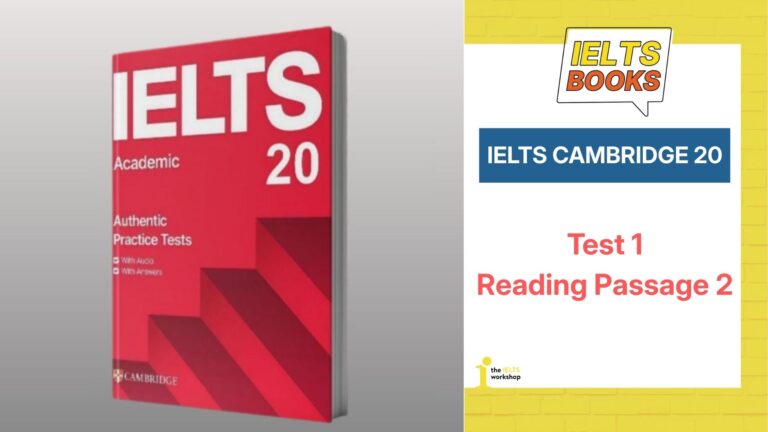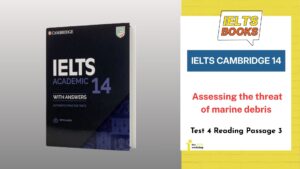Bài viết cung cấp đáp án, bản dịch và hướng dẫn giải chi tiết IELTS Cambridge 20 Test 1 Reading Passage 2 bởi đội ngũ giáo viên uy tín, dày dặn kinh nghiệm của The IELTS Workshop. Hy vọng rằng, sau bài viết này bạn có thể củng cố thêm kiến thức và kĩ năng của mình.
Đáp án IELTS Cambridge 20 Test 1 Reading Passage 2
| Câu hỏi | Đáp án / Từ khóa |
|---|---|
| 14 | C |
| 15 | G |
| 16 | B |
| 17 | E |
| 18 | C |
| 19 | B |
| 20 | A |
| 21 | B |
| 22 | C |
| 23 | A |
| 24 | oak |
| 25 | flooring |
| 26 | keel |
Phân tích chi tiết đáp án IELTS Cambridge 20 Test 1 Reading Passage 2
Question 14. C
Câu hỏi: reference to the research problems that arise from there being only a few surviving large elms.
(Đề cập đến những khó khăn trong nghiên cứu xuất phát từ việc chỉ còn lại rất ít cây elm trưởng thành sống sót.)
Vị trí: Đoạn C.
Transcript: Yet mature specimens have been identified, in counties such as Cambridgeshire, that are hundreds of years old, and have mysteriously escaped the epidemic.
The key, Russell says, is to identify and study those trees that have survived and work out why they stood tall when millions of others succumbed.
Phân tích: Câu này nói rõ rằng số lượng cây elm trưởng thành còn lại rất ít, khiến cho việc nghiên cứu nguyên nhân tại sao chúng sống sót trở nên khó khăn. Đây chính là “research problems” được nhắc tới.
Question 15. G
Câu hỏi: details of a difference of opinion about the value of reintroducing elms to Britain. (Chi tiết về sự bất đồng trong quan điểm về việc tái đưa cây elm trở lại nước Anh.)
Vị trí: Đoạn G.
Transcript: All of this raises questions of social acceptance, acknowledges Russell. … For her, the environmental case for reintroducing elm is strong. … Others are more wary.
Phân tích: Russell tin rằng việc tái trồng elm là tốt cho môi trường, trong khi một số người lại thận trọng hơn. Điều này thể hiện rõ sự khác biệt trong quan điểm.
Question 16. B
Câu hỏi: reference to how Dutch elm disease was brought into Britain. (Nhắc đến cách thức bệnh Dutch elm xâm nhập vào nước Anh.)
Vị trí: Đoạn B.
Transcript: In the ’70s a second epidemic was triggered by shipments of elm from Canada. The wood came in the form of logs destined for boat building … beetles carried a much more virulent strain.
Phân tích: Thông tin này giải thích cách bệnh xâm nhập từ gỗ elm nhập khẩu có vỏ, tạo điều kiện cho bọ cánh cứng mang nấm xâm nhập và lây lan.
Question 17. E
Câu hỏi: a description of the conditions that have enabled a location in Britain to escape Dutch elm disease. (Miêu tả các điều kiện giúp một địa phương ở Anh tránh khỏi bệnh Dutch elm.)
Vị trí: Đoạn E.
Transcript: Local factors appear to have contributed to their survival. Strong winds from the sea make it difficult for the determined elm bark beetle to attack this coastal city’s elm population.
Phân tích: Gió mạnh từ biển khiến bọ cánh cứng khó hoạt động tại Brighton – đây là điều kiện đặc biệt giúp khu vực này có thể bảo tồn số lượng lớn cây elm.
Question 18. C
Câu hỏi: reference to the stage at which young elms become vulnerable to Dutch elm disease. (Nhắc đến giai đoạn cây elm non bắt đầu dễ bị nhiễm bệnh Dutch elm.)
Vị trí: Đoạn C.
Transcript: Once the trunk of the elm reaches 10–15 centimetres or so in diameter, it becomes a perfect size for beetles to lay eggs and for the fungus to take hold.
Phân tích: Khi thân cây elm đạt kích cỡ nhất định, nó trở thành mục tiêu lý tưởng cho bọ cánh cứng, làm tăng nguy cơ nhiễm nấm gây bệnh.
Question 19. B
Câu hỏi: If a tree gets infected with Dutch elm disease, the damage rapidly becomes visible. (Nếu một cây bị nhiễm bệnh Dutch elm, dấu hiệu tổn hại sẽ hiện ra rất nhanh.)
Vị trí: Đoạn F.
Transcript: The effects are very quick,” says Russell. “You return in four to six weeks and trees that are resistant show no symptoms, whereas those that are susceptible show leaf loss and may even have died completely.”
Phân tích: Russell khẳng định rằng nếu cây dễ bị ảnh hưởng, các triệu chứng như rụng lá hoặc chết sẽ xuất hiện chỉ sau vài tuần.
Question 20. A
Câu hỏi: It may be better to wait and see if the mature elms that have survived continue to flourish. (Có lẽ nên chờ đợi xem những cây elm trưởng thành sống sót có tiếp tục phát triển không.)
Vị trí: Đoạn G.
Transcript: Sometimes the best thing you can do is just give nature time to recover … over time, you might get resistance,” says Elliot.
Phân tích: Elliot đề xuất thay vì can thiệp, có thể để tự nhiên điều chỉnh và hy vọng cây sẽ phát triển khả năng kháng bệnh.
Question 21. B
Câu hỏi: There must be an explanation for the survival of some mature elms. (Phải có lý do tại sao một số cây elm trưởng thành lại sống sót.)
Vị trí: Đoạn C.
Transcript: “What are the reasons for their survival?” asks Russell. “Avoidance, tolerance, resistance? … I don’t see how it can be entirely down to luck.”
Phân tích: Russell nghi ngờ khả năng sống sót chỉ nhờ may mắn và khẳng định cần có lời giải thích khoa học cho hiện tượng này.
Question 22. C
Câu hỏi: We need to be aware that insects carrying Dutch elm disease are not very far away. (Chúng ta cần hiểu rằng côn trùng mang bệnh Dutch elm đang ở rất gần.)
Vị trí: Đoạn E.
Transcript: “The beetles can just march in if we’re not careful, as the threat is right on our doorstep,” says Bourne.
Phân tích: Bourne cảnh báo rằng mối đe dọa từ bọ cánh cứng đang hiện hữu rất gần và có thể ập đến nếu lơ là.
Question 23. A
Câu hỏi: You understand the effect Dutch elm disease has had when you see evidence of how prominent the tree once was. (Bạn sẽ nhận ra hậu quả của bệnh Dutch elm khi thấy bằng chứng về sự phổ biến trước kia của loài cây này.)
Vị trí: Đoạn A.
Transcript: The impact of the disease is difficult to picture if you hadn’t seen what was there before … You look at old photographs … and it’s only then that you realise the impact …
Phân tích: Elliot nhấn mạnh việc xem lại ảnh cũ mới giúp ta hiểu được cây elm từng đóng vai trò lớn như thế nào trước khi bị xóa sổ bởi dịch bệnh.
Question 24. oak
Câu hỏi: For hundreds of years, the only tree that was more popular in Britain than elm was … (Trong hàng thế kỷ, loài cây duy nhất phổ biến hơn elm ở Anh là …)
Vị trí: Đoạn D.
Transcript: For centuries, elm ran a close second to oak as the hardwood tree of choice in Britain.
Phân tích: Từ “ran a close second” nghĩa là đứng vị trí thứ hai sau oak, nên đáp án là oak.
Question 25. flooring
Câu hỏi: In the 18th century, it was grown to provide wood for boxes and … (Vào thế kỷ 18, cây này được trồng để cung cấp gỗ làm hộp và …)
Vị trí: Đoạn D.
Transcript: … its wood was used for items such as storage crates and flooring.
Phân tích: “Storage crates” tương ứng với boxes, và vật dụng đi cùng là flooring.
Question 26. keel
Câu hỏi: Due to its strength, elm was often used for mining equipment and the Cutty Sark’s … was also constructed from elm. (Do độ bền cao, elm thường được dùng trong thiết bị khai thác và … của tàu Cutty Sark cũng được làm từ loại gỗ này.)
Phân tích: Keel (thân tàu) được nhắc trực tiếp là một phần cấu trúc được làm từ gỗ elm.
Vị trí: Đoạn D.
Transcript: … was used to build the keel of the 19th-century sailing ship Cutty Sark as well as mining equipment.
Mark Rowe investigates attempts to reintroduce elms to Britain (Mark Rowe điều tra những nỗ lực tái du nhập cây du vào Anh)
Dịch chi tiết IELTS Cambridge 20 Test 1 Reading Passage 2
To Britain
A. Around 25 million elms, accounting for 90% of all elm trees in the UK, died during the 1960s and ’70s of Dutch elm disease. In the aftermath, the elm, once so dominant in the British landscape, was largely forgotten. However, there’s now hope the elm may be reintroduced to the countryside of central and southern England. Any reintroduction will start from a very low base. ‘The impact of the disease is difficult to picture if you ha dn’t seen what was there before,’ says Matt Elliot of the Woodland Trust. ‘You look at old photographs from the 1960s and it’s only then that you realise the impact [elms had] … They were significant, large trees… then they were gone.’
(Khoảng 25 triệu cây du, chiếm 90% tổng số cây du ở Vương quốc Anh, đã chết vào những năm 1960 và 70 do bệnh chết cây du Hà Lan. Sau đó, cây du – từng là loài chiếm ưu thế trong cảnh quan nước Anh – dần bị lãng quên. Tuy nhiên, hiện nay đã có hy vọng rằng cây du có thể được đưa trở lại vùng nông thôn ở miền trung và miền nam nước Anh. Bất kỳ nỗ lực tái trồng nào cũng sẽ phải bắt đầu từ con số rất nhỏ. “Ảnh hưởng của căn bệnh thật khó hình dung nếu bạn chưa từng thấy cảnh vật trước đó,” Matt Elliot từ tổ chức Woodland Trust nói. “Bạn nhìn những bức ảnh cũ từ thập niên 1960 và chỉ lúc đó mới nhận ra ảnh hưởng mà cây du từng có… Chúng là những cây to lớn, quan trọng… rồi bỗng biến mất.”)
Từ vựng cần nhớ:
- accounting for: chiếm (một phần trong tổng thể)
- aftermath: hậu quả, kết quả sau một sự kiện (thường là tiêu cực)
- reintroduced: được đưa trở lại, tái đưa vào (một môi trường nào đó)
B. The disease is caused by a fungus that blocks the elms’ vascular (water, nutrient and food transport) system, causing branches to wilt and die. A first epidemic, which occurred in the 1920s, gradually died down, but in the ’70s a second epidemic was triggered by shipments of elm from Canada. The wood came in the form of logs destined for boat building and its intact bark was perfect for the elm bark beetles that spread the deadly fungus. This time, the beetles carried a much more virulent strain that destroyed the vast majority of British elms.
(Căn bệnh này do một loại nấm gây ra, loại nấm này làm tắc hệ thống mạch dẫn (nơi vận chuyển nước, chất dinh dưỡng và thức ăn) của cây du, khiến các cành bị héo và chết. Đợt dịch đầu tiên xảy ra vào những năm 1920, sau đó dần lắng xuống. Tuy nhiên, vào những năm 1970, một đợt dịch thứ hai bùng phát do các chuyến hàng gỗ du từ Canada. Gỗ được vận chuyển dưới dạng khúc gỗ dùng để đóng thuyền, và lớp vỏ nguyên vẹn của chúng là môi trường hoàn hảo cho loài bọ vỏ cây du – sinh vật lây lan loại nấm chết người này. Lần này, các con bọ mang theo một chủng nấm độc lực mạnh hơn nhiều và đã tàn phá phần lớn số cây du ở Anh.)
Từ vựng cần nhớ:
- vascular system: hệ thống mạch dẫn (trong thực vật, dùng để vận chuyển nước và chất dinh dưỡng)
- virulent: độc lực mạnh, cực kỳ nguy hiểm
- epidemic: dịch bệnh (lây lan trên diện rộng)
C. Today, elms still exist in the southern English countryside but mostly only in low hedgerows between fields. ‘We have millions of small elms in hedgerows but they get targeted by the beetle as soon as they reach a certain size,’ says Karen Russell, co-author of the report ‘Where we are with elm’. Once the trunk of the elm reaches 10–15 centimetres or so in diameter, it becomes a perfect size for beetles to lay eggs and for the fungus to take hold. Yet mature specimens have been identified, in counties such as Cambridgeshire, that are hundreds of years old, and have mysteriously escaped the epidemic.
The key, Russell says, is to identify and study those trees that have survived and work out why they stood tall when millions of others succumbed. Nevertheless, opportunities are limited as the number of these mature survivors is relatively small. ‘What are the reasons for their survival?’ asks Russell. ‘Avoidance, tolerance, resistance? We don’t know where the balance lies between the three. I don’t see how it can be entirely down to luck.’
(Ngày nay, cây du vẫn còn tồn tại ở vùng nông thôn miền nam nước Anh, nhưng chủ yếu là ở các hàng rào cây thấp giữa các cánh đồng. “Chúng ta có hàng triệu cây du nhỏ ở các hàng rào, nhưng chúng bị bọ tấn công ngay khi đạt đến một kích thước nhất định,” Karen Russell, đồng tác giả của báo cáo “Tình hình cây du hiện tại,” cho biết. Một khi thân cây đạt đường kính khoảng 10–15 cm, đó là kích cỡ lý tưởng để bọ đẻ trứng và nấm có thể phát triển. Tuy nhiên, người ta đã phát hiện một số cây trưởng thành ở các quận như Cambridgeshire, có tuổi đời hàng trăm năm và một cách bí ẩn đã thoát khỏi đại dịch.
Russell cho rằng điều quan trọng là xác định và nghiên cứu những cây đã sống sót và tìm hiểu vì sao chúng vẫn đứng vững khi hàng triệu cây khác bị tiêu diệt. Tuy nhiên, cơ hội nghiên cứu là có hạn vì số cây sống sót trưởng thành khá ít. “Nguyên nhân cho sự sống sót của chúng là gì?” Russell hỏi. “Tránh né, chịu đựng hay kháng bệnh? Chúng ta không biết sự cân bằng giữa ba yếu tố này nằm ở đâu. Tôi không nghĩ đó chỉ là may mắn.”)
Từ vựng cần nhớ:
- hedgerows: hàng rào cây bụi
- succumbed: gục ngã, chết vì (bệnh hoặc tác nhân)
- tolerance / resistance / avoidance: khả năng chịu đựng / kháng lại / tránh né (một mối nguy)
D. For centuries, elm ran a close second to oak as the hardwood tree of choice in Britain and was in many instances the most prominent tree in the landscape. Not only was elm common in European forests, it became a key component of birch, ash and hazel woodlands. The use of elm is thought to go back to the Bronze Age, when it was widely used for tools. Elm was also the preferred material for shields and early swords. In the 18th century, it was planted more widely and its wood was used for items such as storage crates and flooring. It was also suitable for items that experienced high levels of impact and was used to build the keel of the 19th-century sailing ship Cutty Sark as well as mining equipment.
(Trong nhiều thế kỷ, cây du được coi là loại gỗ cứng chỉ đứng sau cây sồi tại Anh và trong nhiều trường hợp là loại cây nổi bật nhất trong cảnh quan. Không chỉ phổ biến trong các khu rừng châu Âu, cây du còn trở thành thành phần chính của các khu rừng có cây bạch dương, tần bì và phỉ. Việc sử dụng cây du được cho là bắt đầu từ thời kỳ đồ đồng, khi nó được dùng rộng rãi để làm công cụ. Du cũng là vật liệu ưa thích để làm khiên và các loại kiếm thô sơ. Vào thế kỷ 18, cây du được trồng phổ biến hơn và gỗ của nó được dùng để làm các vật dụng như thùng chứa, sàn nhà. Nó cũng phù hợp cho các vật dụng phải chịu lực va đập cao, như phần sống thuyền của con tàu buồm thế kỷ 19 Cutty Sark cũng như thiết bị khai thác mỏ.)
Từ vựng cần nhớ:
- prominent: nổi bật, dễ thấy
- keel: sống tàu (phần sống lưng ở đáy tàu)
- impact: va chạm, lực tác động
E. Given how ingrained elm is in British culture, it’s unsurprising the tree has many advocates. Amongst them is Peter Bourne of the National Elm Collection in Brighton. ‘I saw Dutch elm disease unfold as a small boy,’ he says. ‘The elm seemed to be part of rural England, but I remember watching trees just lose their leaves and that really stayed with me.’ Today, the city of Brighton’s elms total about 17,000. Local factors appear to have contributed to their survival. Strong winds from the sea make it difficult for the determined elm bark beetle to attack this coastal city’s elm population. However, the situation is precarious. ‘The beetles can just march in if we’re not careful, as the threat is right on our doorstep,’ says Bourne.
(Xét đến việc cây du đã ăn sâu vào văn hóa Anh, không ngạc nhiên khi loài cây này có nhiều người ủng hộ. Trong số đó có Peter Bourne thuộc Bộ sưu tập Cây Du Quốc gia tại Brighton. “Tôi đã chứng kiến bệnh cây du Hà Lan bùng phát khi còn là một cậu bé,” ông nói. “Cây du dường như là một phần của vùng nông thôn nước Anh, nhưng tôi vẫn nhớ cảnh những cái cây rụng hết lá – điều đó ám ảnh tôi mãi.” Ngày nay, thành phố Brighton có khoảng 17.000 cây du. Các yếu tố địa phương có vẻ đã góp phần giúp chúng sống sót. Những cơn gió mạnh từ biển khiến loài bọ vỏ cây du khó tấn công được quần thể cây du ở thành phố ven biển này. Tuy nhiên, tình hình vẫn bấp bênh. “Bọ có thể kéo đến bất cứ lúc nào nếu chúng ta không cẩn thận, bởi mối đe dọa ở ngay trước cửa nhà,” Bourne cảnh báo.)
Từ vựng cần nhớ:
- ingrained: ăn sâu, gắn chặt
- precarious: bấp bênh, nguy hiểm
- advocate: người ủng hộ
F. Any prospect of the elm returning relies heavily on trees being either resistant to, or tolerant of, the disease. This means a widespread reintroduction would involve existing or new hybrid strains derived from resistant, generally non-native elm species. A new generation of seedlings have been bred and tested to see if they can withstand the fungus by cutting a small slit on the bark and injecting a tiny amount of the pathogen. ‘The effects are very quick,’ says Russell. ‘You return in four to six weeks and trees that are resistant show no symptoms, whereas those that are susceptible show leaf loss and may even have died completely.’
(Mọi hy vọng về sự trở lại của cây du phụ thuộc nhiều vào việc cây có khả năng kháng bệnh hoặc chịu được bệnh. Điều này có nghĩa là việc trồng lại trên diện rộng sẽ liên quan đến các giống lai hiện có hoặc mới được lai tạo từ các loài du kháng bệnh, thường là không bản địa. Một thế hệ cây non mới đã được lai tạo và kiểm nghiệm để xem chúng có thể chống chịu với nấm hay không, bằng cách rạch một khe nhỏ trên vỏ cây và tiêm vào một lượng nhỏ mầm bệnh. “Hiệu quả rất nhanh,” Russell cho biết. “Bạn quay lại sau 4 đến 6 tuần, những cây kháng bệnh không biểu hiện gì, trong khi những cây dễ nhiễm sẽ rụng lá và thậm chí có thể chết hoàn toàn.”)
Từ vựng cần nhớ:
- tolerant of: có khả năng chịu đựng
- pathogen: mầm bệnh
- hybrid strain: giống lai
G. All of this raises questions of social acceptance, acknowledges Russell. ‘If we’re putting elm back into the landscape, a small element of it is not native – are we bothered about that?’ For her, the environmental case for reintroducing elm is strong. ‘They will host wildlife, which is a good thing. Others are more wary. ‘On the face of it, it seems like a good idea,’ says Elliot. The problem, he suggests, is that, ‘You’re replacing a native species with a horticultural analogue*. You’re effectively cloning.’ There’s also the risk of introducing new diseases. Rather than plant new elms, the Woodland Trust emphasises providing space to those elms that have survived independently. ‘Sometimes the best thing you can do is just give nature time to recover over time, you might get resistance,’ says Elliot.
(Tất cả những điều này đặt ra câu hỏi về sự chấp nhận của xã hội, Russell thừa nhận. “Nếu chúng ta đưa cây du trở lại cảnh quan, một phần nhỏ của chúng không phải loài bản địa – điều đó có làm chúng ta lo lắng không?” Với cô, lý do môi trường để đưa cây du trở lại là rất thuyết phục. “Chúng sẽ là nơi trú ngụ cho động vật hoang dã, đó là điều tốt.” Tuy nhiên, một số người khác thận trọng hơn. “Thoạt nhìn thì có vẻ là ý tưởng hay,” Elliot nói. Nhưng ông cho rằng: “Bạn đang thay thế một loài bản địa bằng một loài tương tự trong ngành làm vườn. Thực chất là đang nhân bản.” Ngoài ra còn có nguy cơ đưa vào các dịch bệnh mới. Thay vì trồng cây du mới, Tổ chức Woodland Trust nhấn mạnh nên tạo không gian cho những cây đã sống sót tự nhiên. “Đôi khi điều tốt nhất bạn có thể làm là để tự nhiên có thời gian phục hồi, rồi có thể sẽ xuất hiện khả năng kháng bệnh,” Elliot nói.)
Từ vựng cần nhớ:
- clone: nhân bản
- horticultural analogue: loài cây tương tự do con người lai tạo (trong làm vườn)
- wary: thận trọng, cảnh giác
Series giải đề IELTS Cambridge 20:
- [PDF + Audio] Cambridge IELTS 20: Cập nhật mới nhất (Bản đẹp)
- Đáp án & Lời giải chi tiết Cambridge 20: Test 1 – Test 4
- Giải chi tiết Cambridge 20 Test 1 Listening Part 1
- Giải chi tiết Cambridge 20 Test 1 Listening Part 2
- Giải chi tiết Cambridge 20 Test 1 Listening Part 3
- Giải chi tiết Cambridge 20 Test 1 Listening Part 4
- Giải chi tiết IELTS Cambridge 20 Test 1 Reading Passage 1: The Kākāpō
- Giải chi tiết IELTS Cambridge 20 Test 1 Reading Passage 3: How stress affects our judgement
- [PDF + Audio] Trọn bộ Cambridge Practice Tests For IELTS 1 – 20 mới nhất
Nếu bạn đang tìm kiếm một lộ trình học bài bản, phương pháp rõ ràng và sự đồng hành từ những giảng viên giàu kinh nghiệm, The IELTS Workshop chính là nơi bạn có thể tin tưởng.
Khám phá khóa học IELTS miễn phí tại Website The IELTS Workshop để được trải nghiệm phương pháp học hiện đại, lộ trình cá nhân hóa cùng đội ngũ giảng viên chuyên môn cao ngay nhé!



![[PDF + Audio] Trọn bộ Cambridge Practice Tests For IELTS 1 – 20 mới nhất](https://onthiielts.com.vn/wp-content/uploads/2020/04/cam-1-14-764x400.jpg)
![[PDF + Audio] Cambridge IELTS 20: Cập nhật mới nhất (Bản đẹp)](https://onthiielts.com.vn/wp-content/uploads/2025/07/Cambridge-IELTS-20-300x169.jpg)




